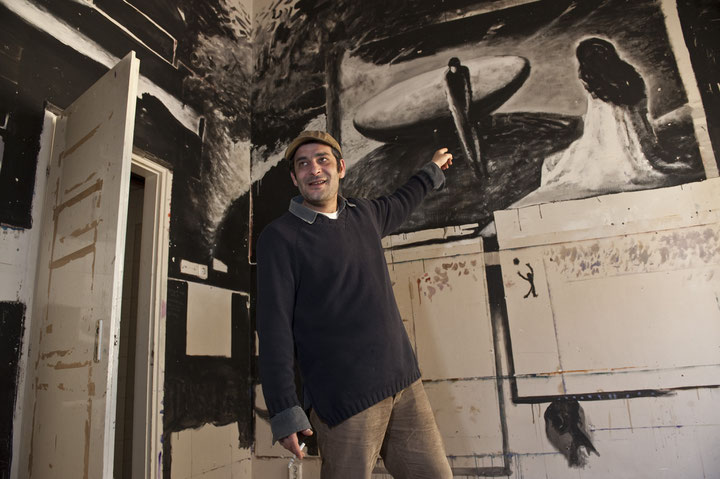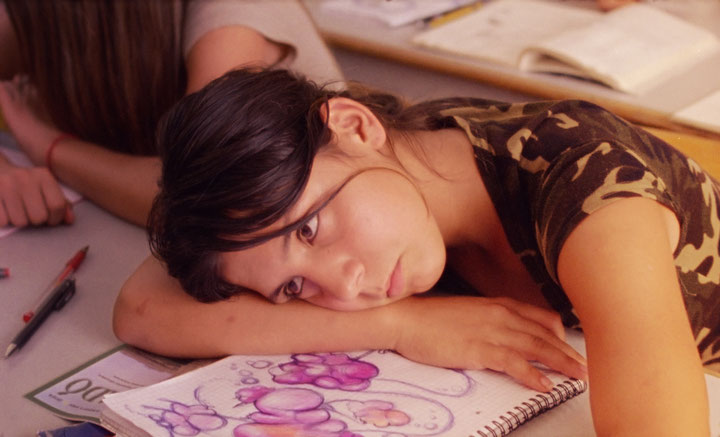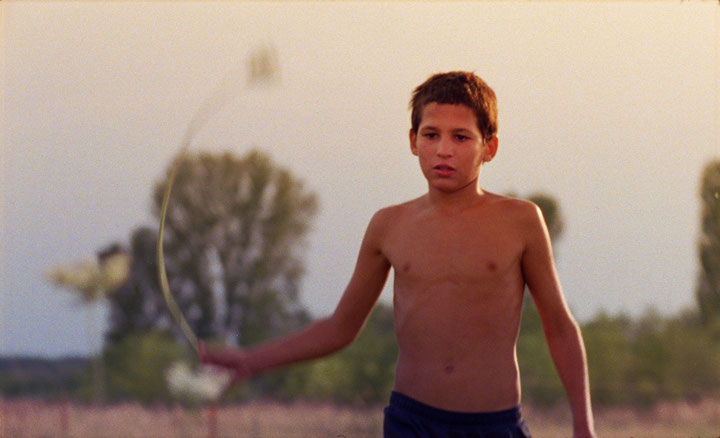Everyday life for Roma communities in Hungary is grim: their small villages and settlements on the outskirts of cities have always been plagued by poverty, marginalisation and a dearth of prospects. The last few years have also seen the emergence of new and unprecedented forms of violent or institutional racism. In addition, under Viktor Orbán’s rightwing conservative government, the Roma culture can no longer count on any kind of state funding. However, painters, designers and video artists continue to struggle to attain recognition and have discovered novel forms of protest.
Budapest: János Bogdán walks past the pile of bulky refuse in the courtyard of the apartment block, rapidly climbs the shabby stairs and walks into the room where he has worked for three years. »This is probably the last time I’ll come here«, says the 36-year-old, peering out at the empty room from beneath his hip-hop cap. The four walls and ceiling in his former studio are covered with comic-style scenes in black and white, addressing human beings and the planets, violence but also love. »I wanted to hold a multimedia performance here with an alternative theatre group; this would have been our set design, if you like. Until late 2011 we hoped that we would still have a little time. But in January the eviction notice arrived«, Bogdán explains and points to the construction workers clearing the last objects out of the former artists’ house before redevelopment work begins.
Until the new right-wing conservative district administration terminated their leases at short notice, the painter shared the building on Hegedü Street, not far from the striking Andrássy Boulevard right in the middle of downtown Budapest, with over 30 colleagues. »Of course everybody knew it was a politically motivated decision. After all, many young, committed and critical artists worked here, and the authorities felt they were not sufficiently national, because they were foreigners, or were ›too liberal‹, or because they were Hungarian Roma like me«, Bogdán tells me with a mix of outrage and irony. Their protests fell on deaf ears. Nowadays Bogdán – nom d’art Amigo – is working with a Hungarian and an Iranian friend in a new studio in Buda, on the other side of the Danube: »Next try«, he laughs as he unlocks the new rooms.
János Bogdán was born in a Roma family in a village on Lake Balaton. »Our home was typical, even stereotypical. There was a lot of music-making, and my father was insistent that I should play the violin, although I was never good at it, and to be quite honest I never felt like it«, the painter recalls with a broad smile. »Fortunately the school was mixed and as small children we were treated the same as the Hungarians up to a certain point. One of my classmates called me ›Amigo‹ and the name stuck«, he continues. After school he studied art in Pécs: most definitely a privilege for a Roma in Hungary. Since then his committed work has above all addressed societal relations in the politically problematic, and in many respects crisis-ridden, Hungarian context.
Amigo has now established a reputation in Hungary as one of the best-known painters of the younger generation. Like many of his colleagues, he has participated in alternative group projects over the last few years and has managed to organise many solo shows. »Amigo has made it; his career is a huge success in the light of the educational and employment situation for most Roma artists in this country«, explains art critic and Roma activist Tímea Junghaus. »Because they grow up in poorer families, often with little access to education, very few Roma artists have a chance to do formal training. It seems fair to assume that most Roma children with an interest in art are the victims of this vicious circle of poverty, exclusion and lack of education«, Junghaus adds.
The general living conditions and educational prospects for Roma in Hungary have seen little improvement over the last few years. Even in the days of state socialism, members of ethnic minorities were, admittedly, considered to be citizens of the Hungarian People’s Republic, with equal rights. In practice however, particularly at the local level, a series of exclusionary mechanisms were in play and blocked social betterment for Roma. As the appearance of an egalitarian state had to be maintained at any price, ethnic discrimination, poverty and unemployment were not addressed.
After the political transition in the 1990s, the Roma were the first victims of economic reforms and of the general transformation sweeping society in Hungary, as was also the case in other post-Socialist countries. Many lost their jobs when ageing, bankrupt factories closed down, and were never able to find work again due to their lack of qualifications. At the same time inequality became more widely accepted in social and political terms: ultimately the desire to live in a capitalist system was deemed to represent a consensus position for the whole of society. The dramatic decline in economic performance led to a slow but undeniable erosion of the classic institutions of the social state in the 1990s, although the phenomenon assumed a less dramatic form in Hungary than in other countries in the region, such as Poland or Romania.
Many observers view 2006 as the point when the unhappy history of the Hungarian Roma most recently took a turn for the worse again. A lengthy period of stagnation, coupled with widespread public disappointment with the Socialist government of the day led to an unprecedented upsurge in right-wing extremism. In a series of murders that shook Hungary, - murders whose precise circumstances have not been clarified fully even today - sympathisers of the paramilitary Hungarian Guard killed six Roma in 2008 and 2009, and injured more than a dozen Roma. In the subsequent parliamentary elections in spring 2010, the radical right wing, anti-Semitic party Jobbik entered the National Assembly, and, having notched up 16 per cent of the vote, became the third most powerful political force in the country.
The rightwing populist party Fidesz won more than two-thirds of the seats in parliament after an election campaign in which it had picked up on many Jobbik issues. In his new role as Prime Minister, Fidesz leader Viktor Orbán promised a fundamental renewal for the country; since then, the spotlight of international attention has been turned on him on countless occasions as a consequence of his authoritarian style of governance. A controversial media bill, placing all radio and TV broadcasters, print media and online news portals under the control of an omnipotent Media Council, was followed by an equally controversial new constitution, which consolidated the prime minister’s power and made his decisions virtually irreversible. A thoroughgoing reform of labour law more or less scrapped provisions on protection against unfair dismissal, cut unemployment benefit cover to three months and compelled the unemployed to do community work.
»The new government shows no real interest in combating exclusion and discrimination affecting socially weaker classes«, Roma activist Tímea Junghaus argues. »The official rhetoric about strengthening medium-sized businesses is in practice tantamount to the state abdicating its social function. Of course, this does not only affect the Roma, but the Roma are among the first victims of this policy«, she continues. The Orbán government did certainly present a new Roma strategy in 2011 with a great media fanfare. However, the new paper contains »hardly any new, concrete and serious proposals«, Sinan Gökcen from the European Roma Rights Center explains, voicing concerns also expressed by other Hungarian and international NGOs.
Rightwing extremist violence, society’s reactions to this violence and authoritarian tendencies in politics and in the public realm have been a focus of concern for many Hungarian intellectuals and artists since these events. Bence Fliegauf’s Film »Just the Wind« addresses fears arising from this new racist violence and won the Jury Grand Prix at this year’s Berlinale. Amigo also engages with this nexus of topics. His portrait »Memento« is a reflection on the plight of the Roma in Hungary and at the same time functions as a commemoration of the victims of racist violence, both in earlier eras and more recently.
Important questions of identity appear in a new light in this complicated societal context. On the one hand, it seems impossible to avoid taking up a clear stance in the Hungarian cultural war that has been raging for years, pitting the »liberals« against the nationalist camp. On the other hand, most independent initiatives and art project rely directly or indirectly on state funding, which is seen as one of the oldest and most significant shortcomings of Hungarian civil society. »This long-standing and lamentable state of affairs now, at least in principle, gives pro-Fidesz decision-makers leverage to blackmail opponents possible, opening the door wide to a new form of self-censorship«, Tímea Junghaus comments.
A number of public and private institutions are already affected by Viktor Orbán’s ambition to bring about a political, and also moral and cultural, renewal of the country. Many small projects for Roma art, launched in the wake of Hungary’s accession to the EU, have now ground to a standstill. The Fidesz government does however seek to burnish its image through symbolic gestures – an older Roma artist, István Szentandrássy, was awarded the prestigious Kossuth Prize on the Hungarian national holiday on 15th March. The PR trick failed lamentably though, as a number of Roma journalists who wanted to report on the official ceremony in parliament were refused entry to the building.
Identity conflicts characteristic of many Roma artists become apparent in Szentandrássy’s oeuvre and biography. Every Monday the painter organises a club evening for Roma intellectuals at which artists from various cultural disciplines discuss their work and the societal and theoretical parameters shaping it. Szentandrássy does not speak any Romany, but instead talks elegant Hungarian with quotations from the classics. In Hungary he is however considered to be one of the founders of the first movement that sought to promote the art and culture, as well as the rights, of the Roma in the 1970s and 1980s. He also frequently addresses the Holocaust, as well as past and recent right-wing extremism – for example, in the portrait »Madonna of Auschwitz«.
One of the few galleries that show exclusively Roma art can be found in the heart of central Budapest, opposite the famous St Stephen’s Basilica. A year ago documentary filmmaker Edit Köszegi, decided to convert a magnificent old flat on the second floor of a Jugendstil apartment block into an art space and to present her impressive collection of paintings, graphic works and design there. Oil paintings, watercolours and small sketches hang close together on the walls in the three rooms of the Kugler Gallery, whilst the shelves are full of designer jewellery, art books and photographs. An installation with a bicycle adorned with brightly coloured fabric welcomes visitors in the hall.
»The initiative grew out of my work with the Budapest Museum of Ethnography«, Köszegi explains, taking a seat next to the piano in the large salon in her gallery. »In the 1990s I made several documentary films about Roma communities and met a lot of artists in the process. Then the Soros Open Society Foundation funded a large public collection of Roma art. The museum’s collection grew larger every year, and since its inception parts of the collection have been shown several times in Hungary and abroad, to great public and critical acclaim. However no further exhibitions have been arranged since the new government took power. Over the years I also bought paintings myself and developed my own collection. Of course it is by no manner of means as large as the official collection, but I wanted to at least give art lovers a chance to discover some works by Roma artists once again «, she explains.
Köszegi is now not only showing her private collection but is striving to run a real gallery and to offer artists a chance to find customers. »In the light of the ongoing economic crisis it is very difficult in Hungary at the moment, as very few people are interested in Roma art and even fewer people can afford to buy art«, Köszegi notes. »However, selling even just one work means a great deal to many artists, who are struggling not just to achieve recognition but also to survive.«
Translated by Helen Ferguson


